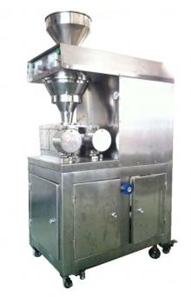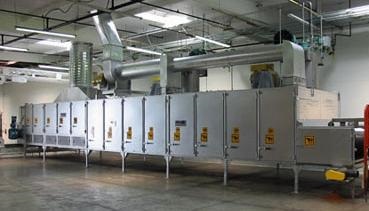Cereal manufacturing encompasses many fundamental chemical engineering unit operations. This module starts with the grain being crushed or ground in preparation for cooking. Whole kernels can be used, as well depending on the desired end product. Once reduced to the proper size, the grain or kernel is moved to a pressure cooker, where additives like seasonings are infused. After additional processing and pressure cooking, the material is typically partially dried, further sized and formed, tempered, and then fully dried to the finished food specifications. Another method of cooking is extrusion. At the extruder, product is fed through, cooking is finalized, and the cereal comes out in the desired shape using die plates and inserts. From here the product is sent to the mill to be tempered and fully dried. Finally, the product is packaged and shipped.
Preparation
Size Reduction
Two of the most common methods for size reduction in breakfast cereal manufacturing are the hammer mill, and the roller mill, shown below. Size reduction is an important step to increase surface area and ingredient performance of the cereal before it is sent to the pressure cooker. Additionally, this step helps to remove the inedible outer bran layer from cereal grains.
Production
Cooking
The next operation to be performed is the infusion of additives into the cereal grains, which takes place in a pressure cooker. Additives like chocolate and important vitamins can be infused into the cereal in this step. This is one of the most important steps, in that it characterizes what cereal grain product is being made.
Dryer
The grain is dried of excess water but is still left in a mushy solid form that can be molded into whatever shape it needs to be for the final product. A single conveyer dryer is used often in these processes due to the large-scale production required, but various other types of dryers are applicable. The continuous flow of a conveyer dryer makes it very useful for large-scale manufacturing. As can be seen in the picture of a conveyer dryer, below, there are a variety of cells (zones). At each of these cells, the grain is exposed to different processing conditions including temperature, and airflow direction.
Extruder
Many cereal grain processes combine final cooking and extrusion into one step, though sometimes separate cooking and forming extruders are used. If one extruder unit is used, the cereal is heated as it goes through the extruder unit and then it is formed to shape as it comes out through the die. Recall that the cereal grain was not completely dried in the dryer so as to be wet enough to be able to be formed into its desired final product when pushed through the die. The specific additives added in the pressure-cooking stage will depend on how the extrusion process works, causing varying cook time, hardness, and other texture characteristics. A twin-screw extruder is pictured below.
Cooling and Tempering
Most cereal products are sent to a grain silo to cool and temper until they are ready to be packaged and shipped out. This time frame depends on a lot of other parameters in the process, and if packaging and shipping are backed up, grain can wait in this unit for a while.
Quality Control and Preservation
Quality Control
All food must undergo rigorous quality control as any defect can cause large issues for the consumer. Cereal is a product that has a lower risk for food poisoning relative to other foods but is still subject to high-quality standards. The main areas of quality control for cereal are raw-material harvesting, post-harvest handling, processing, product packaging, storage, and distribution. This includes careful inspection of the grain at all steps for any foreign material or abnormalities, careful monitoring of temperature and moisture content, water activity, and vitamin and nutrition checks before being sent to packaging.
Packaging and Shipping
Once the cereal is in its desired final product form, it is time to package it. Cereals tend to be relatively resistant to moisture damage. Two common forms of cereal packaging are using a plastic bag to encapsulate the cereal and/or sealing it in a cardboard box. When cereal is packaged in a moisture-proof plastic bag or in other materials and structures used for packaging, it is sealed with heat to ensure minimal moisture exposure. Different materials for packaging are used according to certain requirements, such as preventing the migration of moisture or oxygen and upholding safety standards. The cardboard box is folded to the proper shape, then sealed with weak glue to ensure that the consumer can easily open it.
Acknowledgements
- Baker Perkins Group Ltd., Grand Rapids, MI
- Buhler Aeroglide, Cary, NC
- Mendel Company, East Hanover, NJ
References
- Burlington, Kimbarlee J. “Keeping the Crunch in Breakfast Cereals.” Natural Products INSIDER. N.p., 1 June 2001. Web. 12 Dec. 2016.
- “Cereal.” How Cereal Is Made – Material, Making, Used, Processing, Product, Industry, Machine. N.p., n.d. Web. 9 Dec. 2016.
- Koch, Kim. “Hammermills and Roller Mills.” MF2048 Hammermills and Roller Mills (n.d.): n. pag. Kansas State, May 2002. Web. 9 Dec. 2016.
- “Particle Size Reduction.” Particle Size Reduction – Feed Mill Machinery Glossary | FeedMachinery.com. Feed Machinery, 2016. Web. 9 Dec. 2016.
- “Quality Assurance for Small-scale Rural Food Industries – Chapter 2 Quality Assurance of Selected Commodities.” Quality Assurance for Small-scale Rural Food Industries – Chapter 2 Quality Assurance of Selected Commodities. Food and Agriculture Association of United Nations, n.d. Web. 9 Dec. 2016.
- Saravacos, George D., and Zacharias B. Maroulis. “Chapter 11: Drying Operations” Food Process Engineering Operations. Boca Raton, FL: CRC, 2011. 61-78. Print.
Developers
- Fritz Hyde



